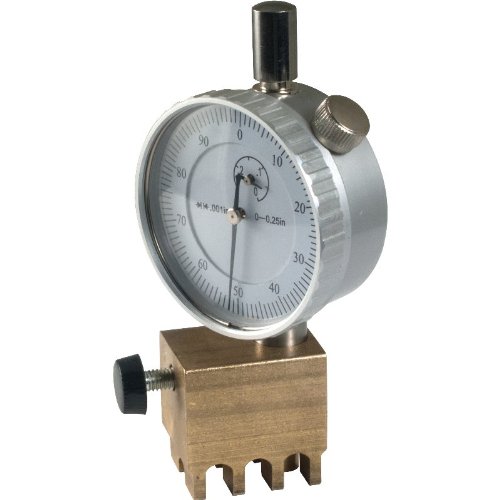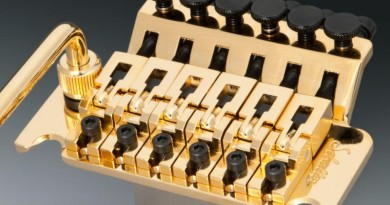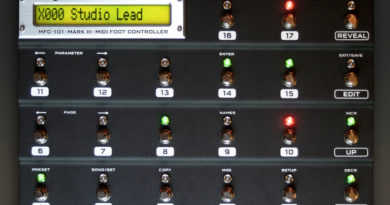Lok-N-Roll Compensated Locking Nut
The Lok-N-Roll compensated locking nut is exactly what you need for even better tuning of your locking tremolo system!

That’s right. I said it. But what did I say? LOL!
I said better tuning. A quality locking tremolo system, such as the Floyd Rose, stays in tune just fine. We are talking here about putting it in tune. And not just in tune, but in tune… better.
The deal with guitars in general is that the standard fingerboard has the frets laid out in a bit of a mathematical hodgepodge for perfect tuning. Let’s say that you have your guitar set up perfectly. Neck relief. String action. Intonation. It can still sound wonky. Hence the issue: the intonation. Even with an ideal match with the common “12th fret technique”, it’s still not perfect across the entire fret board. The science of where each fret would need to be for each string makes it a literal nightmare.
And that is where a compensated nut comes in to play. Compensated? What does that mean? It means that the nut has a design that affects the length of the strings. The idea might be a little more common for an open nut, more so than a locking nut. Check out this photo of the business end of an unlocked Lok-N-Roll:

The alterations in each string length balances the temperament to more accurately achieve a more perfect overall tuning. This has been relatively unheard of in locking tremolo systems. At least, not without physical and probable irreversible changes to the frets and/or fret board.
For this evaluation, I am installing the Lok-N-Roll compensated locking nut on a few guitars. One is a 25-1/2″ (Fender) scale neck with 09-42 strings. Another is a 24-3/4″ (Gibson) scale with 10-46 strings. Both originally have authentic Floyd Rose locking nuts. The Lok-N-Roll comes with screws for either top mount or the old school rear mount. In this instance, both guitars are top mount.
Install is super easy. I like to block off the Floyd Rose tremolo so that it doesn’t risk going back and messing up the finish. For that, I prefer a simple block-style eraser. After removing the nut clamp blocks, loosen the strings so that they can easily be moved to either side of the nut. Some players facilitate a string spreader for help with that. Using the appropriate screwdriver, remove the mounting screws and the original locking nut.
From there, it’s essentially the reverse process to install the Lok-N-Roll compensated locking nut. I do like to take my time when tightening the mounting screws. This allows for being able to make sure everything seats properly and evenly. You want a snug fit, but be careful to not over-tighten.
Once the strings are back in the proper channels and you are all in tune, you might encounter your only curve ball. The locking screws for the new nut clamp blocks use a 2.5 mm allen wrench. This is the same wrench you already have for your intonation screws down at the saddles.
At this point, my first concern is the action at the 1st fret. Before I started, I put my trusty Nut Slotting Gauge to use. String clearance at the 1st fret is a big deal for me. Nothing ruins your day more than the action at the nut being .005″ off. Because, yes, it can throw off your entire setup. However… on both guitars, the Lok-N-Roll compensated nut matches the clearance perfectly. When they say it’s the little things that mean a lot, they aren’t kidding. HaHa!
When locking down the nut clamp blocks, the Lok-N-Roll clamp blocks are designed to fill up the space. That is to say, the blocks are maximized to full up the space to reduce twisting when tightening. This is key for the string to stay in tune during the locking process.
The falloff angle on the headstock side of the nut is also important. The string tree is meant to keep the strings at the ideal angle as they come off the nut. If the angle is too high or too low, the string tuning can be affected when clamping down the locking nut. And that can take valuable play out of the range of the fine tuners. The Lok-N-Roll compensated nut is designed with a built-in break angle intended to eliminate the string tree. You can always keep the string tree on there, if you want… I’m not gonna tell you how to live your life. LOL!
Check out this video of the Lok-N-Roll highlights, including an install demo by Mike Learn:
What do I think? I think that it’s great.
Once the install is complete, I’m checking all the specs and tuning up and down the neck. The intonation is right there in place from where it was prior to the nut swap. Frets all up and down the neck are in tune. Not a few cents here or there. But actually in tune. Chords have more musicality and the overall results are just more harmonious. Tapped harmonics are also much easier to nail.
The slight shift in the string temperaments results in a more consistent feel from the tension across all strings. It’s not something you automatically think of as “the strings are obviously different!” as much as a subtle change in the vibe of how the instrument plays and performs. The designer of Lok-N-Roll works with many shred players and gets a lot of feedback with regard to less fatigue in the hands.
The Lok-N-Roll compensated nut is made with a proprietary selection of materials. Sorry, gentle readers. I’d like to know as much as you, but I also understand we can’t always know what goes into the sausage. I do know the the character is alive and the test guitars seemed to have more natural sustain with the Lok-N-Roll in place.
When it comes to design, the Lok-N-Roll is just as refined as it is effective. It retains that basic classic “locking nut” appearance, while presenting a more sleek approach. And being a locking nut first and foremost, you should find this an excellent upgrade for any locking nut that a Floyd Rose spec would normally fit.
At the end of the day, I’m blown away by the Lok-N-Roll compensated locking nut. It does what is says it will do and it does it well. Or let me put it like this… I have one or maybe two guitar builds on the launch pad. And while I have a workbench full of parts, the Lok-N-Roll compensated locking nut is now what I’m considering for those. I think that if you have a Floyd Rose style locking tremolo system and that you are serious about the quality of your tuning, that you’ll want (at least) one of these.
The Lok-N-Roll compensated locking nut comes in R2 (1.625″/41.30 mm) and R3 (1.6875″/42.85 mm) nut widths. They are available in chrome, black, and gold finishes. You can order the compensated locking nuts directly from Lok-N-Roll and they will soon be available via Floyd Rose as well.
Lok-N-Roll Website | Facebook | Twitter | YouTube | Instagram
Floyd Rose Website | Facebook | Twitter | YouTube
7 string 16Ω 59 Airbucker Alnico 2 Alnico 3 Alnico 4 Alnico 5 Alnico 8 Bare Knuckle BKP Brown Sound Celestion Ceramic Custom Shop Dean DiMarzio DMT Dual Resonance EVH Fishman Floyd Rose Fluence Gibson Humbucker Ibanez JB Jimmy Page John Petrucci MJ Mojotone P90 PAF Pariah Pickup Satch Satriani Schaller Seymour Duncan Singlecoil Single Width Speaker Steve Vai Tech Tip Virtual Vintage




